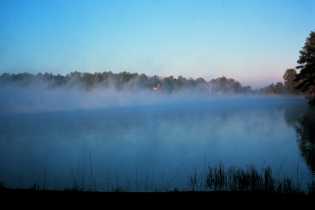|
water vapor condenses and a steam fog forms. An upslope fog forms when moist air if forced up a slope. These certainly occur as the air encounters hilly terrain and is forced to rise, or if moist air travels up a very long slope. Such might be the situation when air moves out of the Gulf of Mexico traveling west up the Great Plains toward the east slope of the Rocky Mountains (see Figure 7.16). As the air rises it expands and adiabatically cools. Once the air temperature reaches the dew point temperature the air becomes saturated, and condensation occurs to form the fog. Frontal fogs are associated with weather fronts, especially a warm front. Warm, moist air rises up and over cooler, drier air at the surface along a warm front. As precipitation falls from the warmer air into the drier air some of the water evaporates and humidifies the cooler air. As the humidification process brings the cooler air to its saturation point a fog forms.
|

